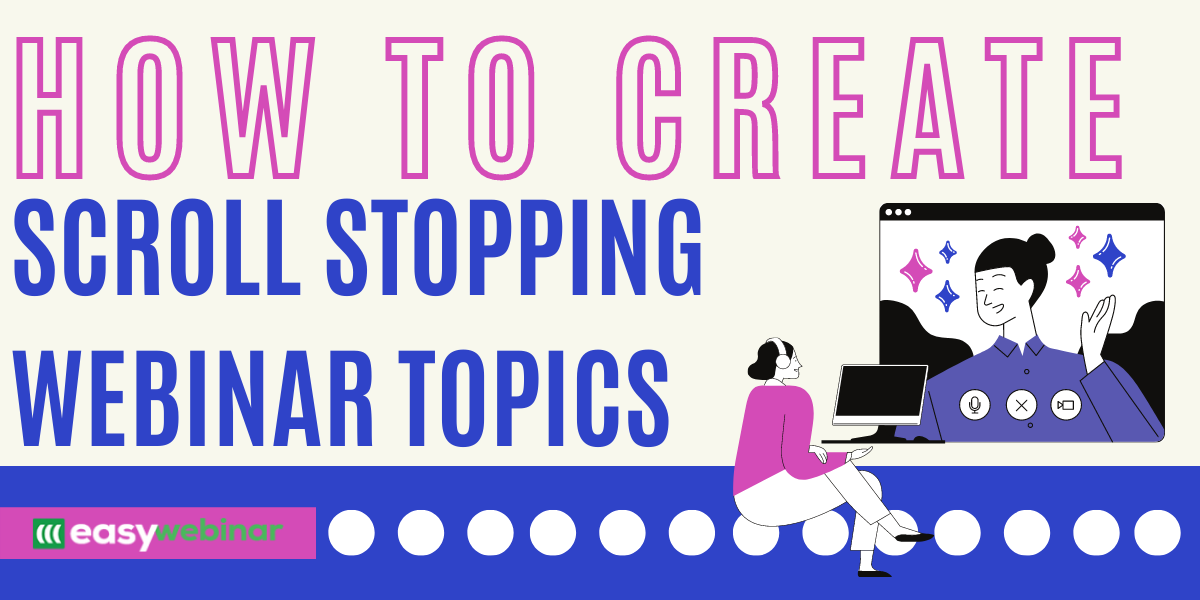How to Create Scroll Stopping Webinar Topics

Don’t you hate it when you spend tons of time creating an epic webinar but hardly anyone shows up and attends? For many entrepreneurs who are just starting out with webinars, this is frustrating but not uncommon.
Here’s the thing, no one will know if your content is good if they don’t want to sign up for your webinar. One of the easiest ways to improve registration rates is choosing an epic webinar topic.
Choosing your webinar topic is very important as people need to want to learn more about the specific topic so they click, register, and attend.
I like to think of it like writing an excellent blog post or an email to your audience. While you need great content to keep them engaged, you need to get them to open the email or read the blog post first.
How do you do that?
By creating a captivating title or subject line that intrigues the reader.
As marketing legend David Ogilvy said, “On the average, five times as many people read the headline as read the headline as read the body copy. When you have written your headline, you have spent eighty cents on the out of your dollar.”
Topics and titles for webinars are very similar to creating headlines that readers want to open and read. They are part art and part science, but don’t worry, both of which can be learned.
Here’s how you can get those scroll-stopping topics figured out for your audience.
How to Pick Your Webinar Topics

Before jumping into some of the most common ways to find your perfect webinar topic, let’s first create the mindset for success. After running webinars for nearly a decade and working with tons of 7-figure entrepreneurs, one thing is common among all of them.
Every single entrepreneur is obsessed with testing! You need the same mentality when running webinars, whether it’s your first or your 100th event.
Test, test, and test some more.
Now that you’re ready to test, let’s jump in.
Similar to writing headlines, there isn’t one single way to create killer webinar topics. Here are some of my favorite strategies to help you get started.

1. Use Course Modules As Topics
First things first, if your goal is to sell a course or program, you probably have already broken it down into core modules and lessons within each module. To easily find a webinar topic, you can simply use each module for your topic.
But here’s the thing, you don’t want to teach the “How to” on the webinar (this is what your course is for). Teaching too much “How to” content leads to overwhelming attendees and overwhelmed people never buy anything.
Instead, you want to teach them “What” to do without going into all the details. During the webinar teach the “What” (explain what the topic is all about) and the “Why” it’s important to your success.
Then, once they’re ready to learn more, offer them the “How to” which is your course and/or group coaching program. The pitch is at the end of the sales webinar (roughly around 40 minutes in) is where you transition and invite them to join your paid program.
Course Module Example
Let’s use an example to make it super clear how this works.
Imagine that you are a copywriter who’s selling a $497, 6-module online course to help struggling writers learn how to start a copywriting business. One of the modules is all about learning how to pitch clients and land paid gigs.
On the webinar, you could teach what to do to land clients but not the actual how-to (which is what your paid program is for).
Here are some title ideas for the webinar:
- 3 Strategies to Land Your First Copywriting Client
- How to Find Your First Copywriting Client in 30 Days or Less
The cool thing is that most online courses are 4-8 modules which means you could test out each one as a different webinar topic! Remember, the most successful entrepreneurs are always testing.
My only recommendation is to make sure that you don’t overshare too much on the webinar content. Share more about “What” they need to do instead of going into the full “How to” content (save that for your program).
2. Use Part of Your Unique Framework

The second way to create webinar topics is by talking about your framework or unique method that makes up your program. Sticking with our copywriting example, imagine you’ve created your own system called “The Copywriter Code.”
Let’s say the Copywriter Code consists of three distinct parts:
- Part 1: Building a Portfolio
- Part 2: Pitching Clients
- Part 3: Crafting Epic Copy
Each part is crucial to the success of the others and you need all three to work together to find success. Using this example, you could either:
- Run a webinar about each part of your framework.
Or
- Run a webinar about your entire system teaching “What” they need to be a successful copywriter.
If you don’t have a unique framework or methodology, I suggest creating one ASAP. Not only will this differentiate you from the competition but it will help you create content that will attract your ideal audience. All of your free content on social media can come from the framework as well as webinar topics.
Remember, this helps you stand out and have a higher level of market sophistication than your competition. Since it’s cheaper and easier than ever to sell online courses, you need to stay one step ahead of your competitors. Your unique methodology does just that.
Having your own patented system allows you to do just that and is a win-win strategy!
3. Learn From Your Audience
For more information, insights and inspiration (especially if you already have webinars created on your program modules and just want to boost more engagement) you can do the following:
Ask Your Audience

Arguably the easiest way to come up with more webinar topics is to simply ask people who are already following you! Start by interviewing people in your target audience (or even friends and family who are like the people you’re trying to attract).
You can do this all sorts of ways:
Survey Your Email List
Send them a short survey (and maybe an incentive to fill it out, like a gift card) where you give them 3-4 choices on webinar topics. You can sign up for something like Survey Monkey, create a short survey in a few minutes, and send the link to your email list. Remember when sending surveys, keep them easy for users to fill out quickly!
Please don’t let your email list or follower size hold you back from surveying! Even if you have 100 followers or a small email list, these are still real people who need your help. Listening to what they want and need is crucial in creating the right webinar topic.
Poll Followers
An easy way to test out webinar topics before creating any actual content is to poll your social media followers. Instagram makes this easy with stories as you can post polls or multiple choice options.
Ask Your Facebook Group
If you have a free Facebook group, ask them more about their struggles and what they want to learn also. Regardless of total Facebook group size, this is still incredibly valuable information and can also help engagement of your group as well.
Also, don’t discount your members just because you have a smaller following than others. These people are following you for a reason so make sure to deliver and help them get the results they deserve.
Study Competitors

Finally, studying competitors is never a bad idea either. Let me be clear, I am not saying that you should run the same webinar as your competitor. This is a losing formula!
Instead, you should study what’s working and what’s not. See if you can find any feedback or reviews about the webinar on forums or Facebook groups. Read reviews on competing webinars and see what questions were left unanswered!
4. Reverse Webinar Topics
As I mentioned before, creating webinar topics is both an art and a science. You need to give attendees a combination of what they want with what they actually need.
One way to do this is by presenting a “reverse” webinar topic.
Let’s stick with our copywriting example from before. Instead of having your webinar topic be around “How to find clients,” you would offer the reverse, which would read something like:
- 3 Ways You’re Repelling Copywriting Clients
- Why You Aren’t Landing Copywriting Clients
- Top 3 Reasons Why You Aren’t Landing Clients
This strategy works well because it taps into the fear and current struggles of your audience.
In this example, your audience is likely writers who are struggling with landing clients and creating consistent income. By having a webinar all about what’s not working, it will likely connect with their current situation
Think about it, people want to leave the hell they’re in ASAP. A bold webinar reverse topic will help trigger the “Fight or flight” part of the brain and likely get them to take action.
5. Choose Auxiliary Topics

The final strategy is to use auxiliary topics as well. For example, Rosetta Stone could co-host some awesome webinars about travel, even though they don’t provide travel products themselves. Their audience, of course, is often studying language because they travel or want to travel (You’re welcome for the idea, Rosetta Stone.)
As you do more research and really start to understand your audience, you might find some hidden benefits as well. When you get to the heart of scroll-stopping webinar topics for your business, you also uncover needs that your target audience has.
Who knows…maybe you’ll figure out a new product or service that’s needed, too!
Final Thoughts
Scroll-stopping webinar topics are the gatekeeper to getting people into your webinars. Even the best webinar content still needs the right topic as a frame to let your target audience know how you can help them achieve their goals.
Remember, picking your webinar topic is just as important as the webinar content itself. While you should spend plenty of time on the actual webinar slides and rehearsal of your event, don’t skimp on the topic. Otherwise, you run the risk of creating epic content that very few people see and likely a lot fewer sales as well.
Don’t forget, creating the right webinar topic is about giving people what they want but also giving them what they need. By using any and all of these methods, you will find the topic that converts like crazy.
Finally, keep testing even when things are going well. By staying proactive and hungry for success, you are much more likely to continue growing your business. As James Caan said,
“Never stop asking yourself whether you can do things better. Keep testing every aspect of your business to the nth degree and challenge every one of your assumptions. The tougher you are on yourself now, the tougher your business will be out there in the real world.”
Next Steps
Ready to start testing out new webinar topics with the #1 webinar platform? Then make sure to take advantage of our 14-day FREE trial with EasyWebinar.
>>Click here to find the best plan that works for you.
